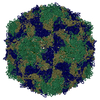+ データを開く
データを開く
- 基本情報
基本情報
| 登録情報 | データベース: PDB / ID: 7vy6 | ||||||
|---|---|---|---|---|---|---|---|
| タイトル | Coxsackievirus B3(VP3-234N) incubate with CD55 at pH7.4 | ||||||
 要素 要素 |
| ||||||
 キーワード キーワード | VIRUS / CVB3 | ||||||
| 機能・相同性 |  機能・相同性情報 機能・相同性情報regulation of lipopolysaccharide-mediated signaling pathway / negative regulation of complement activation / regulation of complement-dependent cytotoxicity / regulation of complement activation / respiratory burst / positive regulation of CD4-positive, alpha-beta T cell activation / positive regulation of CD4-positive, alpha-beta T cell proliferation / Class B/2 (Secretin family receptors) / ficolin-1-rich granule membrane / complement activation, classical pathway ...regulation of lipopolysaccharide-mediated signaling pathway / negative regulation of complement activation / regulation of complement-dependent cytotoxicity / regulation of complement activation / respiratory burst / positive regulation of CD4-positive, alpha-beta T cell activation / positive regulation of CD4-positive, alpha-beta T cell proliferation / Class B/2 (Secretin family receptors) / ficolin-1-rich granule membrane / complement activation, classical pathway / transport vesicle / side of membrane / COPI-mediated anterograde transport / endoplasmic reticulum-Golgi intermediate compartment membrane / secretory granule membrane / Regulation of Complement cascade / positive regulation of T cell cytokine production / virus receptor activity / positive regulation of cytosolic calcium ion concentration / membrane raft / Golgi membrane / innate immune response / lipid binding / Neutrophil degranulation / cell surface / extracellular exosome / extracellular region / plasma membrane 類似検索 - 分子機能 | ||||||
| 生物種 |   Coxsackievirus B3 (コクサッキーウイルス) Coxsackievirus B3 (コクサッキーウイルス) Homo sapiens (ヒト) Homo sapiens (ヒト) | ||||||
| 手法 | 電子顕微鏡法 / 単粒子再構成法 / クライオ電子顕微鏡法 / 解像度: 3.02 Å | ||||||
 データ登録者 データ登録者 | Wang, Q.L. / Liu, C.C. | ||||||
| 資金援助 |  中国, 1件 中国, 1件
| ||||||
 引用 引用 |  ジャーナル: Proc Natl Acad Sci U S A / 年: 2022 ジャーナル: Proc Natl Acad Sci U S A / 年: 2022タイトル: Molecular basis of differential receptor usage for naturally occurring CD55-binding and -nonbinding coxsackievirus B3 strains. 著者: Qingling Wang / Qian Yang / Congcong Liu / Guoqing Wang / Hao Song / Guijun Shang / Ruchao Peng / Xiao Qu / Sheng Liu / Yingzi Cui / Peiyi Wang / Wenbo Xu / Xin Zhao / Jianxun Qi / Mengsu Yang / George F Gao /  要旨: Receptor usage defines cell tropism and contributes to cell entry and infection. Coxsackievirus B (CVB) engages coxsackievirus and adenovirus receptor (CAR), and selectively utilizes the decay- ...Receptor usage defines cell tropism and contributes to cell entry and infection. Coxsackievirus B (CVB) engages coxsackievirus and adenovirus receptor (CAR), and selectively utilizes the decay-accelerating factor (DAF; CD55) to infect cells. However, the differential receptor usage mechanism for CVB remains elusive. This study identified VP3-234 residues (234Q/N/V/D/E) as critical population selection determinants during CVB3 virus evolution, contributing to diverse binding affinities to CD55. Cryoelectron microscopy (cryo-EM) structures of CD55-binding/nonbinding isolates and their complexes with CD55 or CAR were obtained under both neutral and acidic conditions, and the molecular mechanism of VP3-234 residues determining CD55 affinity/specificity for naturally occurring CVB3 strains was elucidated. Structural and biochemical studies in vitro revealed the dynamic entry process of CVB3 and the function of the uncoating receptor CAR with different pH preferences. This work provides detailed insight into the molecular mechanism of CVB infection and contributes to an in-depth understanding of enterovirus attachment receptor usage. | ||||||
| 履歴 |
|
- 構造の表示
構造の表示
| ムービー |
 ムービービューア ムービービューア |
|---|---|
| 構造ビューア | 分子:  Molmil Molmil Jmol/JSmol Jmol/JSmol |
- ダウンロードとリンク
ダウンロードとリンク
- ダウンロード
ダウンロード
| PDBx/mmCIF形式 |  7vy6.cif.gz 7vy6.cif.gz | 179.6 KB | 表示 |  PDBx/mmCIF形式 PDBx/mmCIF形式 |
|---|---|---|---|---|
| PDB形式 |  pdb7vy6.ent.gz pdb7vy6.ent.gz | 139.3 KB | 表示 |  PDB形式 PDB形式 |
| PDBx/mmJSON形式 |  7vy6.json.gz 7vy6.json.gz | ツリー表示 |  PDBx/mmJSON形式 PDBx/mmJSON形式 | |
| その他 |  その他のダウンロード その他のダウンロード |
-検証レポート
| 文書・要旨 |  7vy6_validation.pdf.gz 7vy6_validation.pdf.gz | 1.1 MB | 表示 |  wwPDB検証レポート wwPDB検証レポート |
|---|---|---|---|---|
| 文書・詳細版 |  7vy6_full_validation.pdf.gz 7vy6_full_validation.pdf.gz | 1.1 MB | 表示 | |
| XML形式データ |  7vy6_validation.xml.gz 7vy6_validation.xml.gz | 37.4 KB | 表示 | |
| CIF形式データ |  7vy6_validation.cif.gz 7vy6_validation.cif.gz | 57 KB | 表示 | |
| アーカイブディレクトリ |  https://data.pdbj.org/pub/pdb/validation_reports/vy/7vy6 https://data.pdbj.org/pub/pdb/validation_reports/vy/7vy6 ftp://data.pdbj.org/pub/pdb/validation_reports/vy/7vy6 ftp://data.pdbj.org/pub/pdb/validation_reports/vy/7vy6 | HTTPS FTP |
-関連構造データ
| 関連構造データ |  32195MC  7vxhC  7vxzC  7vy0C  7vy5C  7vykC  7vylC  7vymC  7w14C  7w17C M: このデータのモデリングに利用したマップデータ C: 同じ文献を引用 ( |
|---|---|
| 類似構造データ |
- リンク
リンク
- 集合体
集合体
| 登録構造単位 | 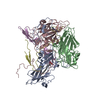
|
|---|---|
| 1 | x 60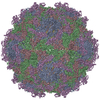
|
| 2 |
|
| 3 | x 5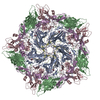
|
| 4 | x 6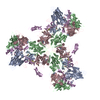
|
| 5 | 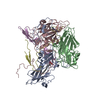
|
| 対称性 | 点対称性: (シェーンフリース記号: I (正20面体型対称)) |
- 要素
要素
-Capsid protein ... , 4種, 4分子 ABCD
| #1: タンパク質 | 分子量: 31703.477 Da / 分子数: 1 / 由来タイプ: 組換発現 由来: (組換発現)   Coxsackievirus B3 (コクサッキーウイルス) Coxsackievirus B3 (コクサッキーウイルス)細胞株 (発現宿主): HEK293 / 発現宿主:  Homo sapiens (ヒト) Homo sapiens (ヒト) |
|---|---|
| #2: タンパク質 | 分子量: 28862.561 Da / 分子数: 1 / 由来タイプ: 組換発現 由来: (組換発現)   Coxsackievirus B3 (コクサッキーウイルス) Coxsackievirus B3 (コクサッキーウイルス)細胞株 (発現宿主): HEK293 / 発現宿主:  Homo sapiens (ヒト) Homo sapiens (ヒト) |
| #3: タンパク質 | 分子量: 26128.633 Da / 分子数: 1 / 由来タイプ: 組換発現 由来: (組換発現)   Coxsackievirus B3 (コクサッキーウイルス) Coxsackievirus B3 (コクサッキーウイルス)細胞株 (発現宿主): HEK293 / 発現宿主:  Homo sapiens (ヒト) Homo sapiens (ヒト) |
| #4: タンパク質 | 分子量: 7437.209 Da / 分子数: 1 / 由来タイプ: 組換発現 由来: (組換発現)   Coxsackievirus B3 (コクサッキーウイルス) Coxsackievirus B3 (コクサッキーウイルス)細胞株 (発現宿主): HEK293 / 発現宿主:  Homo sapiens (ヒト) Homo sapiens (ヒト) |
-タンパク質 / 非ポリマー , 2種, 2分子 E

| #5: タンパク質 | 分子量: 28641.074 Da / 分子数: 1 / 由来タイプ: 組換発現 / 由来: (組換発現)  Homo sapiens (ヒト) / 遺伝子: CD55, CR, DAF / 細胞株 (発現宿主): HEK293 / 発現宿主: Homo sapiens (ヒト) / 遺伝子: CD55, CR, DAF / 細胞株 (発現宿主): HEK293 / 発現宿主:  Homo sapiens (ヒト) / 参照: UniProt: P08174 Homo sapiens (ヒト) / 参照: UniProt: P08174 |
|---|---|
| #6: 化合物 | ChemComp-PLM / |
-詳細
| 研究の焦点であるリガンドがあるか | N |
|---|---|
| Has protein modification | Y |
-実験情報
-実験
| 実験 | 手法: 電子顕微鏡法 |
|---|---|
| EM実験 | 試料の集合状態: PARTICLE / 3次元再構成法: 単粒子再構成法 |
- 試料調製
試料調製
| 構成要素 |
| ||||||||||||||||||||||||
|---|---|---|---|---|---|---|---|---|---|---|---|---|---|---|---|---|---|---|---|---|---|---|---|---|---|
| 分子量 | 実験値: NO | ||||||||||||||||||||||||
| 由来(天然) |
| ||||||||||||||||||||||||
| 由来(組換発現) |
| ||||||||||||||||||||||||
| ウイルスについての詳細 | 中空か: NO / エンベロープを持つか: NO / 単離: STRAIN / タイプ: VIRION | ||||||||||||||||||||||||
| 天然宿主 | 生物種: Homo sapiens | ||||||||||||||||||||||||
| 緩衝液 | pH: 7.4 | ||||||||||||||||||||||||
| 試料 | 包埋: NO / シャドウイング: NO / 染色: NO / 凍結: YES | ||||||||||||||||||||||||
| 試料支持 | グリッドのタイプ: PELCO Ultrathin Carbon with Lacey Carbon | ||||||||||||||||||||||||
| 急速凍結 | 装置: FEI VITROBOT MARK IV / 凍結剤: ETHANE / 湿度: 100 % / 凍結前の試料温度: 277 K |
- 電子顕微鏡撮影
電子顕微鏡撮影
| 実験機器 |  モデル: Titan Krios / 画像提供: FEI Company |
|---|---|
| 顕微鏡 | モデル: FEI TITAN KRIOS |
| 電子銃 | 電子線源:  FIELD EMISSION GUN / 加速電圧: 300 kV / 照射モード: FLOOD BEAM FIELD EMISSION GUN / 加速電圧: 300 kV / 照射モード: FLOOD BEAM |
| 電子レンズ | モード: BRIGHT FIELD / 倍率(公称値): 75000 X / 最大 デフォーカス(公称値): 2500 nm / 最小 デフォーカス(公称値): 1500 nm / Calibrated defocus min: 1800 nm / 最大 デフォーカス(補正後): 5000 nm / Cs: 2.7 mm / C2レンズ絞り径: 70 µm / アライメント法: COMA FREE |
| 試料ホルダ | 凍結剤: NITROGEN 試料ホルダーモデル: FEI TITAN KRIOS AUTOGRID HOLDER 最高温度: 70 K / 最低温度: 70 K |
| 撮影 | 平均露光時間: 1 sec. / 電子線照射量: 40 e/Å2 / 検出モード: COUNTING フィルム・検出器のモデル: FEI FALCON III (4k x 4k) |
| 画像スキャン | 横: 4096 / 縦: 4096 |
- 解析
解析
| EMソフトウェア |
| ||||||||||||||||||||||||||||||||||||||||||||||||||
|---|---|---|---|---|---|---|---|---|---|---|---|---|---|---|---|---|---|---|---|---|---|---|---|---|---|---|---|---|---|---|---|---|---|---|---|---|---|---|---|---|---|---|---|---|---|---|---|---|---|---|---|
| CTF補正 | タイプ: PHASE FLIPPING AND AMPLITUDE CORRECTION | ||||||||||||||||||||||||||||||||||||||||||||||||||
| 粒子像の選択 | 選択した粒子像数: 158446 | ||||||||||||||||||||||||||||||||||||||||||||||||||
| 3次元再構成 | 解像度: 3.02 Å / 解像度の算出法: FSC 0.143 CUT-OFF / 粒子像の数: 34135 / 対称性のタイプ: POINT | ||||||||||||||||||||||||||||||||||||||||||||||||||
| 原子モデル構築 | プロトコル: RIGID BODY FIT / 空間: REAL | ||||||||||||||||||||||||||||||||||||||||||||||||||
| 原子モデル構築 | 3D fitting-ID: 1 / Accession code: 1COV / Initial refinement model-ID: 1 / PDB-ID: 1COV / Source name: PDB / タイプ: experimental model
|
 ムービー
ムービー コントローラー
コントローラー












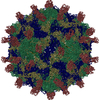
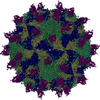

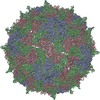
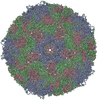
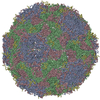

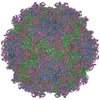
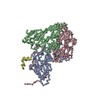
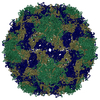
 PDBj
PDBj










